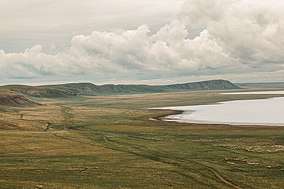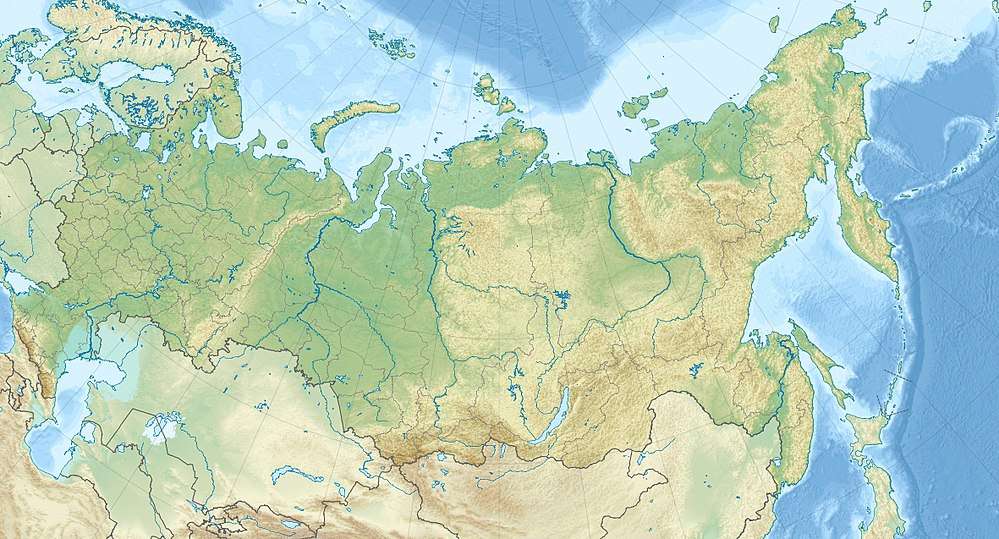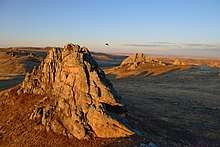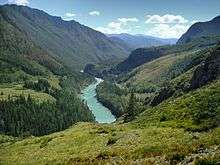Daursky Nature Reserve
The Daurian Nature Reserve (Даурский заповедник Daurskiy zapavyednik) is a nature reserve situated in the southern part of the Zabaykalsky Krai in Siberia, Russia, close to the border with Mongolia. It is part of a World Heritage Site named "The Landscapes of Dauria".[1]
| Daursky Nature Reserve | |
|---|---|
 Lake Zun-Torey | |
 | |
| Location | Zabaykalsky Krai, Russia |
| Area | 208.6 ha |
| Established | 1987 |
| World Heritage site | 2017 |
| Type | Natural |
| Criteria | ix, x |
| Designated | 2017 (41st session) |
| Part of | Landscapes of Dauria |
| Reference no. | 1448 |
The reserve has been established in 1987 to protect the dry steppes and wetlands of South Siberia. It is contiguous with the Dornod Mongol Biosphere Reserve in Mongolia, a 8,429,072 hectares (20,828,690 acres) area of steppe immediately to the south.[2]
The reserve comprises 208.600 ha, of which about 163.800 ha constitute the buffer zone. The core area is of about 44.800 ha and is divided into 9 plots. The buffer zone of the reserve covers two large lakes called Barun-Torey and Zun-Torey.
Ecoregion and climate


The Daurian Reserve is located in the Daurian forest steppe ecoregion, a band of grassland, shrub terrain, and mixed forests in northeast Mongolia and a portion of Siberia, Russia.
The climate at the Daurian Reserve is Subarctic climate, dry winter (Köppen climate classification Subartic climate(Dwc)). This climate is characterized by mild summers (only 1-3 months above 10 °C (50.0 °F)) and cold winters having monthly precipitation less than one-tenth of the wettest summer month.[3][4]
Flora and fauna
The vertebrate fauna includes 48 mammal species, 317 bird species, 3 reptile species, 3 amphibian species and 4 species of fish. In addition, there are about 800 species of insects. The reserve also contains a colony of the rare Iris potaninii.[5] It had been planned to introduce the Przewalski horse to the reserve in the 1980s, but the plans were cancelled following the collapse of the Soviet Union, although hopes for their implementation were rekindled in 2009.[6] Mammals of the reserve included on the IUCN red list are dzeren, pallas cat and Daurian hedgehog. Recently a new zakaznik, the Dzeren Valley (Долина дзерена Dalina dzyeryena), has been created in the area to ensure migration of the dzeren between Russia and Mongolia.[7]
Potential reintroduction of Argali has been proposed.[8]
References
- https://whc.unesco.org/en/list/1448/indicators/
- Blunden, Jane (2014). Mongolia. Bradt Travel Guides. p. 148. ISBN 978-1-84162-416-7.
- Kottek, M., J. Grieser, C. Beck, B. Rudolf, and F. Rubel, 2006. "World Map of Koppen-Geiger Climate Classification Updated" (PDF). Gebrüder Borntraeger 2006. Retrieved September 14, 2019.CS1 maint: multiple names: authors list (link)
- "Dataset - Koppen climate classifications". World Bank. Retrieved September 14, 2019.
- "The exhibition "Iris Russia"". flower-iris.ru. Retrieved 12 May 2015.
- T.L. Zharkikh: The Workshop on the A-Line Przewalski horse. News Biosphere Reserve "Askania Nova", vol. 11, 2009
- WWF-Russia (November 2011): New refuge for Mongolian Gazelle
- Biodiversity conservation is a priority of the Russian Ministry of Natural Resources
External links
- Daursky Nature Reserve at www.rusnature.info
- Daursky Nature Reserve at mapcarta.com
- Whitleyaward - Vadim Kirilyuk: Research and Conservation of migrating Mongolian Gazelles across Russian-Mongolian Border, Russia
| Wikimedia Commons has media related to Daursky Reserve. |





